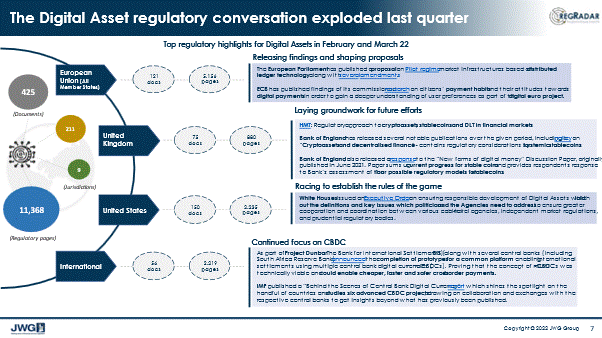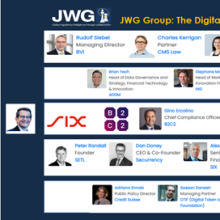Yesterday, 22 digital asset regulators and market participants gathered virtually across 39 jurisdictions to debate the RegTech challenges presented by digital assets. Tracking this sector’s regulatory obligations is like playing a three dimensional game of chess and small details can make or break markets. In this article we recap where we took away, how you can access the recordings are and what comes next.
Background
With a $2 Trillion market cap, Digital Assets are a hot topic globally. JWG’s RegRadar has picked up 425 regulatory documents from 9 jurisdictions comprising 11,368 pages which reveal the tremendous promise of faster, safer, cheaper, digital, more democratised finance through this asset class.
JWG Feb-March Digital Asset RegRadar

In the past month, US policy makers have fired the starting gun, The European Parliament has issued a DLT pilot regime report, The FCA has issued a notice to regulated firms with cryptoassets, the Bank of England has issued policy on crypto and De Fi, and the PRA has issued a dear CEO letter on cryptoassets, MIT and the BoE have announced a 12 month collaboration, The BIS has issued a report on international settlements using multi-CBDCs and IOSCO has issued a Decentralized Finance Report. The UK finance ministry announced plans to become a global leader in Digital Assets on 4 April in a paper here.
The RegTech challenge
At the heart of the Digital Asset compliance challenge lies an equivalence question: have policies which are at least as good as TradFi been applied? JWG’s research has shown that DA compliance has the opportunity to eat TradFI compliance for breakfast:
- We see opportunity for RegTech to enable digitally-native compliance
- Winners will deploy data-driven controls that provide trust which the market requires
- TradFi and digital rail interoperability will be achieved through protocols and standards.
However, As Digital Assets move into the realm of TradFi, the interoperability, transparency and liquidity of the markets depend on common safety standards and communication protocols within the FS infrastructure. To achieve the levels of trust required, global collaboration between market participants and their regulators is critical to defining ‘what good looks like’.
The Seminar
On 5th April JWG assembled 22 all-star speaker from 7 firms, 2 regulators, 6 associations and nearly 10 vendors. See here for agenda.
Speakers:
- The state of global digital asset policy: BIS, BVI, Barclays, CMS, GDF
- Protecting investors: ADGM, Former FDIC, GDCA, ING
- Protecting the markets & FMI: B2C2, Securrency, Zodia Custody
- Managing risk: BNY Mellon, Securrency, SETL, SIX, SWIFT
- 2022 priorities: Credit Suisse, DTIF, Loughborough Uni, Perella Weinberg
Audience: Thus far we have had nearly 140 attendees from over 30 jurisdictions.
Key takeaways
The 5 hours of debate revealed an opportunity for financial services to deploy RegTech to get truly digital compliance right from the start:
- There are virtually no areas of FS infrastructure that will go untouched over the next 2 years
- Digitally-native compliance has become a strategic battleground for market participants
- The 3D policy chess is complicated, but the prizes are big, and collaboration helps the combatants
- The RegTech building blocks are in place, we just need to will to deploy common rule libraries, policies, and control systems
- Winners will be leaning in and there is a real chance that you will be missing out soon.
This transformation is, however, not going to happen by itself, requires a well thought through approach, partnership, and planning.
Next steps
As a next step, JWG will be kicking off a second phase of research into RegTech controls for AML, Sanctions and Surveillance with an aim to link the TradFi and Digital Asset agendas.
See here for the new website.
Get in touch with admin@regrisksolutions.com if you’d like to find out more!


